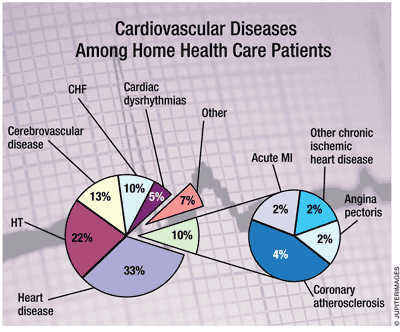U.S. Pharm. 2010;35(2):10.
Despite declines in recent years, cardiovascular disease (CVD) is the leading cause of death in people of most ethnicities. Death due to CVD occurs equally among men and women. Among noninstitutionalized adults, 12% (26.6 million) have been diagnosed with CVD, versus 43% of nursing home residents. Coronary artery disease is the most common type of CVD. Every year, 785,000 Americans have a first heart attack (HA), and 470,000 Americans with at least one previous HA have another. In the United States, an HA occurs every 34 seconds, and every minute someone dies from a CVD-related event. Within 6 years of having an HA, 22% of men and 46% of women develop heart failure (HF), which could be a contributing cause of death. The quality of life and life expectancy of patients with HF improve with early diagnosis and treatment of CVD.

Atrial fibrillation (AF) increases the risk of CVD and stroke. Its prevalence increases significantly as adults age, and it is estimated that AF has been diagnosed in 2.2 million adults. AF is more prevalent in men than in women, with white subjects having a higher prevalence than African American subjects. Other factors associated with development of AF include hypertension (HT), congestive HF (CHF), previous myocardial infarction (MI), and diabetes mellitus (DM). People with high cholesterol double their risk of having an HA. High blood pressure (BP) increases the risk of CVD, but 32% of individuals do not know that they have high BP. Obesity contributes to CVD, and 66.7% of the adult population is overweight or obese. Physical inactivity is associated with an increased risk of CVD.
Home health care (HHC) is the fastest-growing segment of the health care system. Each day, more than 1 million U.S. patients receive HHC. Most patients are female (67%) and married (32%) or widowed (35%); the average age is 70 years, and 71% of patients are aged 65 years or older. The most common diagnosis upon admission to an HHC agency is CVD (12%), followed by DM (8%). More than three-quarters of HHC patients suffer from heart disease, HT, cerebrovascular disease, or CHF; anginal pain, MI, ischemia, and coronary atherosclerosis affect another 10%. These figures indicate that HHC agencies primarily provide skilled rehabilitative and therapeutic services or “medically oriented” home care. Medically oriented HHC represents less than half of formal HHC services rendered to the long-term care population.
In 2009, CVD was estimated by the Centers for Disease Control and Prevention to cost $304.6 billion. Costs for health care services, medications, and lost productivity were included in this sum. Coronary heart disease accounted for an estimated $151.6 billion, and HF accounted for $30 billion.
To comment on this article, contact rdavidson@uspharmacist.com.




